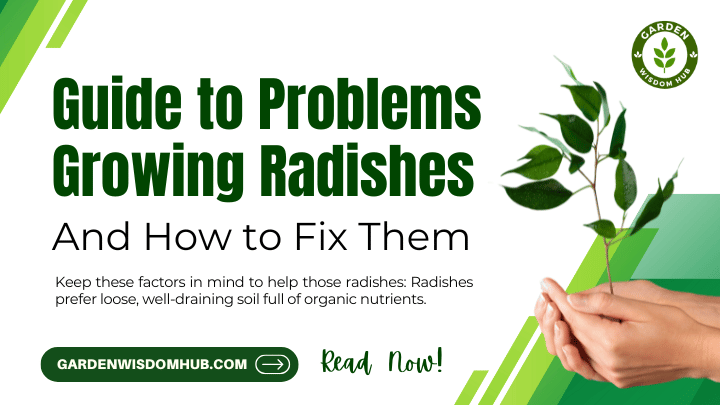Problems Growing Radishes and How to Fix Them
Troubleshooting Radish Ruckus and Fixing It Radishes are like garden race cars, going from seed to salad quickly! Green thumbs everywhere choose them for their zesty taste.
However, a few bothersome gremlins can stymie growth! This tutorial will cover radishes growing issues and offer solutions to help you harvest a bumper crop. Read this article till the end to explore all the problems growing radishes and how to fix them.
How Do You Make Radishes Grow Better?
Keep these factors in mind to help those radishes: Radishes prefer loose, well-draining soil full of organic nutrients.
Preparing the soil with compost or organic matter improves its texture and fertility! Radishes need space to grow. Once they develop their two real leaves, space the seedlings 2 inches apart to avoid a jungle!
Steady she goes:
Keeping the watering can nearby keeps the soil sponge-like without becoming a swamp. Mulching keeps moisture snug like a bug in a rug, like a blanket on your garden!
Sunlight:
Radishes need six hours of sunlight to thrive and grow like weeds! Tuck them into a sunny spot, such a south-facing patch where the sun shines brighter than a rooster’s crow at dawn!
Balanced Fertilization:
Instead of producing leaves like crazy, choose a fertilizer with low nitrogen and lots of phosphate and potassium to help those roots
What Causes Radishes to Not Develop?
Radishes growing like daisies can be hampered by garden gremlins:
Excess nitrogen:
Too much nitrogen is like giving a youngster a mound of candy—it makes the leaves wild but neglects the roots! Avoid fresh manure and high-nitrogen fertilizers—they’re like skunks at garden parties!
Improper Thinning:
Radishes packed like sardines compete for nutrition, resulting in poor bulb growth. Allow seedlings to breathe to grow like weeds!
Watering Like a Headless Chicken:
Without continuous moisture, your roots will be confused like a cat in a dog park! Moisten that soil like a sponge in a rainfall!
Problems with soil:
Radishes may give up when the earth is harsh or weak in nutrients! Shake the dirt and add compost to assist the roots grow!
What Are the Common Problems in Radish?
Radishes Playing Peek-a-Boo:
Radish bulbs pop their heads above the soil when planted too shallow or in tight soil. Put the seeds half an inch deep and loosen the soil to allow the roots dig like treasure hunters!
Radishes Parting Ways:
Radishes that look worn out may have an erratic watering routine or have stayed too long at the garden party! Radishes should be harvested before they start playing hide-and-seek to keep the soil happy.
Bolting Radishes:
Radishes sometimes give up and blossom and seed early in hot weather. Jumping the gun! Get your hands dirty in the cooler months and pick bolt-resistant beauties, or you may be chasing your tail!
Swiss Cheese Radish Leaves:
It appears that flea beetles are feasting and creating their trademark holes in the leaves! Row covers deter pests and welcome beneficial insects like ladybugs—the garden’s MVPs!
What is the Best Fertilizer for Radishes?
Radishes grow like fish in water with a balanced fertilizer that’s low in nitrogen but high in phosphate and potassium—allowing their roots to extend.
Organic choices like well-rotted compost and bone meal are best for soil improvement. They’re great at improving soil! If your plants are dragging, give them a side-dress to motivate them while planting!
Why Are My Radishes Long and Thin?
Radishes that stretch like rubber bands instead of plumping up. It may be caused by several reasons.
In overcrowding, roots stretch like they’re reaching for the heavens. Provide at least 2 inches of space between sprouts to avoid them feeling like sardines in a can!
Compacted soil:
Radishes that are too long grow in hard soil because it slows root growth. Before planting your small green pals, shake and shimmy the earth down to 6 inches!
Too Little Sunlight:
Radishes need six hours of sunlight daily to take up the rays. Too much shade can hinder bulb growth!
Why Do My Radishes Not Form Bulbs?
Radishes may not bulb for several reasons: High nitrogen can be one of the reasons. Too much nitrogen in the soil makes plants go leafy instead of bulb-producing.
The shallow planting method Radish seeds may produce a lot of lush greens but no bulbs if planted as they’re just starting off.
Too many radishes in one place should be avoided. Radishes don’t develop when packed like sardines because they struggle for nutrition.
Radish Pests and How to Control Them
How to Treat Radish Pests Radishes can be eaten by many pests!
The flea beetles:
They make Swiss cheese from leaves like little hole punchers! Spread a blanket over those rows, welcome the nice bugs, and try organic insecticides!
Aphids:
Like uninvited visitors at a party, these green creatures arrive in droves and settle in. They kill plants faster than a youngster with candy.
Watch out for these pests or you’ll have Aphids are vampires that drain leaves, leaving them twisted and yellow like a coal mine canary! Why not give ladybugs the red carpet or use neem oil to keep them away?
Root Maggots:
If it isn’t the little pests that think they can mess up the garden! These bugs are like uninvited visitors at a party, eating the roots and causing difficulty.
Talk about a pain! Stay alert or you may These little guys own radish roots by digging in! Rotate crops and use floating row coverings to deter pests! It’s like kicking them out while maintaining your garden!
How Much Sun Do Radishes Need?
Radishes need at least 6 hours of sunlight a day to survive, like beachgoers.
Put them in a bright area, like a south-facing garden bed, where they can soak up the sun like a cat on a windowsill!
Why Are My Radishes So Small?
Small radishes can appear for many reasons:
Too many radishes in one place:
Small roots result from competition for space. Leave space between seedlings to avoid stepping on one other.
To give roots a fighting chance, make sure the soil is rich as a king’s ransom and loose as a goose!
Watering:
If you treat your plants like a seesaw, their roots won’t know whether to grow or vacation! Moisten that soil like a sponge in a rainfall!
Thin Radishes: Causes and Solutions
Compacted soil:
Thin radishes grow from compacted soil. Root growth slows like a turtle in a race on rock-hard soil. Before planting, tickle the dirt and watch the seeds fly.
Overcrowding:
Sardine-packed plants compete for nutrients. Let seedlings breathe to grow like weeds.
By solving these issues and following the instructions, you can harvest a radish harvest to die for! Keep an eye on the soil, water deeply, and keep pests at bay to help your radishes grow like weeds!
Conclusion: Problems Growing Radishes and How to Fix Them
Radishes are fun to grow, but they can run into issues like stubborn bulbs, bugs, or stray leaves.
With some elbow grease and luck, radishes may thrive in well-drained soil, a little water, and some sunshine. You’ll be laughing all the way to the salad bowl with a big harvest.
Moreover, do not forget to check out our other articles. Some of these are as following:
- When to Harvest Butternut Squash
- Growing Lettuce in Containers
- How to Harvest Lettuce Seeds
- Growing Radishes in a Container
FAQs: Problems Growing Radishes and How to Fix Them
Why aren’t my radishes producing bulb?
The issue may be a result of too many cooks in the kitchen. If those little creatures are packed in tighter than sardines, the soil is hard as a rock, or they’re getting more nitrogen than a body can shake a stick at, you may be wrong about bulb formation
Why are my radish leaves growing while the roots are hiding?
You may be adding too much nitrogen or not giving the roots enough sunlight.
How often should I water my radishes?
Radishes appreciate sponge-like soil, but don’t drown them or you’ll get root rot!
What can I do to prevent pests from damaging my radishes?
To prevent bugs from eating my radishes, cover them with row covers, rotate crops, and clean up the garden like guests.
Can we keep Radishes in pots?
You bet your boots! Radishes grow like fish in water in containers with loose, well-drained soil of the correct depth. These conditions make them happy as clams!
James Porter
Welcome to our haven of gardening and plant care, where outdoor and indoor planting enthusiasts come together! At Gardening Wisdom Hub, we aim to provide you with the most authentic information on anything related to gardening, plant care, seasonal planting etc.
The author of our website is James Porter, an experienced industry veteran. He has a deep interest in everything green. James’s enthusiasm for exploring plants’ features and learning new gardening methods began at a young age. Gradually, his passion increased with time, leading him to become a highly esteemed professional. His extensive knowledge makes him a priceless resource for inexperienced and seasoned gardeners.

